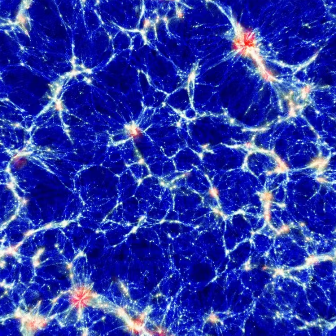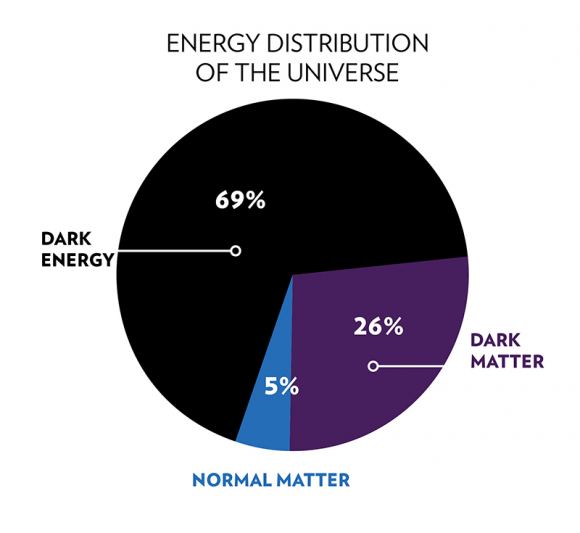Video: Het Kosmische Web, of: Hoe ziet het universum eruit op ZEER grote schaal?
============================
Een draad van het kosmische web: astronomen zien een galactische gloeidraad van 50 miljoen lichtjaar
(machinevertaling uit het Engels)

Op de grootste schalen is materie in het heelal gerangschikt in een kosmisch web dat bestaat uit filamenten van gas gescheiden door holtes, met clusters waar de filamenten elkaar ontmoeten. Credit: MAGNETICUM-simulatie, met dank aan Klaus Dolag, Universitäts-Sternwarte München, Ludwig-Maximilians-Universität München, Duitsland
Op de grootste schaal bestaat het heelal uit een “kosmisch web” gemaakt van enorme, dunne filamenten van gas die zich uitstrekken tussen gigantische klompen materie. Of dat is wat onze beste modellen suggereren. Het enige dat we tot nu toe met onze telescopen hebben gezien, zijn de sterren en sterrenstelsels in de klompjes materie.
Dus is het kosmische web echt, of een verzinsel van onze modellen? Kunnen we onze modellen bevestigen door deze zwakke gasvormige filamenten direct te detecteren?
Tot voor kort waren deze filamenten ongrijpbaar. Maar nu heeft een samenwerking tussen Australische radioastronomen en Duitse röntgenastronomen er een gedetecteerd.
CSIRO’s onlangs voltooide Australian Square Kilometre Array Pathfinder (ASKAP)-telescoop in West-Australië begint een grootschalig beeld van het heelal te produceren in radiofrequenties. Deze telescoop kan dieper kijken dan welke andere radiotelescoop dan ook en doet nieuwe ontdekkingen, zoals de onverklaarbare Odd Radio Circles of ORC’s.
Zien met radiogolven en röntgenstralen
Dit jaar zijn ook de eerste waarnemingen gepubliceerd door de Duitse eROSITA-ruimtetelescoop, die ons ons diepste grootschalige beeld van het heelal in röntgenfrequenties geeft. Beide telescopen van de volgende generatie hebben een ongekend vermogen om grote delen van de hemel tegelijk te scannen, dus ze zijn prachtig op elkaar afgestemd om de grootschalige kenmerken van het heelal te bestuderen. Samen kunnen ze veel meer dan alleen, dus natuurlijk hebben we onze krachten gebundeld.
Het eerste resultaat van deze samenwerking is de ontdekking van een kosmische gloeidraad van heet gas. Deze studie werd geleid door Thomas Reiprich van de Universiteit van Bonn en Marcus Brueggen van de Universiteit van Hamburg, en er waren Australische wetenschappers van CSIRO en van de universiteiten Curtin, Macquarie, Monash en Western Sydney bij betrokken. Het is vandaag gepubliceerd in twee artikelen in het tijdschrift Astronomy and Astrophysics.
Het kosmische web
De oerknal 13,8 miljard jaar geleden produceerde een heelal gevuld met onzichtbare donkere materie, samen met een karakterloos gas van waterstof en helium, en weinig anders. Gedurende de volgende paar miljard jaar klonterde het gas samen onder de aantrekkingskracht van de zwaartekracht en vormde het filamenten van materie met enorme lege holtes ertussen. De filamenten bevatten waarschijnlijk meer dan de helft van de materie in het heelal, hoewel de filamenten zelf slechts tien deeltjes per kubieke meter bevatten – minder dan het beste vacuüm dat we op aarde kunnen creëren.
Bijna alle sterrenstelsels die we vandaag zien, inclusief onze eigen Melkweg, zouden in deze filamenten zijn gevormd. We denken dat sterrenstelsels dan langs de filamenten glijden totdat ze in de dichte clusters van sterrenstelsels vallen die samenklonteren op kruispunten waar filamenten samenkomen.
Maar tot nu toe was dit allemaal hypothetisch – we konden de sterrenstelsels en clusters zien, maar we konden de gasvormige filamenten zelf niet zien. Nu heeft eROSITA het hete gas direct gedetecteerd in een gloeidraad van 50 miljoen lichtjaar lang. Dit is een belangrijke stap voorwaarts en bevestigt dat ons model van het kosmische web correct is.
Een vlotte rit
We hadden ook verwacht dat het hete gas elektronen zou opzwepen om radiofrequentie-emissies te produceren, maar vreemd genoeg detecteren we de gloeidraad niet met ASKAP. Dit vertelt ons dat het hete gas soepel stroomt, zonder de turbulentie die elektronen zou versnellen om radiogolven te produceren. Dus de sterrenstelsels krijgen een soepele rit als ze in de clusters vallen.
We kunnen de individuele sterrenstelsels zien vallen in de clusters in de radiobeelden van ASKAP. Op radiogolflengten zien we vaak sterrenstelsels tussen een paar jets, veroorzaakt door elektronen die uit de buurt van het zwarte gat in het centrum van de Melkweg spuiten.

ASKAP-radiogegevens (wit) als overlay op het eROSITA-röntgenbeeld (gekleurd). De cirkels tonen individuele radiosterrenstelsels. De jets van de radiosterrenstelsels, die normaal gesproken recht zijn, worden in verwrongen vormen gebogen door de intergalactische winden in de clusters. Credit: Marcus Brueggen
In onze radiobeelden van deze clusters zien we echter dat de jets verbogen en vervormd worden terwijl ze worden geteisterd door intergalactische winden in het dichte gas in de clusters. Nogmaals, dit is een goede bevestiging van onze modellen.
Dit werk is niet alleen belangrijk als bevestiging van ons model van het heelal, maar is ook het eerste resultaat dat voortkomt uit de samenwerking tussen ASKAP en eROSITA. Deze twee telescopen zijn prachtig op elkaar afgestemd om ons heelal te onderzoeken, het heelal te zien zoals het nog nooit eerder is gezien, en ik verwacht dat deze ontdekking de eerste van vele zal zijn.
Meer informatie: Radio-waarnemingen van het fuserende clustersysteem Abell 3391-Abell 3395, arXiv:2012.08775 [astro-ph.HE] arxiv.org/abs/2012.08775
Het Abell 3391/95 melkwegclustersysteem: een intergalactisch medium emissiefilament van 15 Mpc, een warme gasbrug, invallende materieklonten en (opnieuw) versneld plasma ontdekt door SRG/eROSITA-gegevens te combineren met ASKAP/EMU- en DECam-gegevens, arXiv: 2012.08491 [astro-ph.CO] arxiv.org/abs/2012.08491
Source: https://sciencex.com/news/2020-12-thread-cosmic-web-astronomers-million.html (December 2020)
====================== ===========================
A thread of the cosmic web: Astronomers spot a 50 million light-year galactic filament

On the largest scales, matter in the Universe is arranged in a cosmic web consisting of filaments of gas separated by voids, with clusters where the filaments meet each other. Credit: MAGNETICUM simulation, courtesy of Klaus Dolag, Universitäts-Sternwarte München, Ludwig-Maximilians-Universität München, Germany
At the largest scale, the Universe consists of a “cosmic web” made of enormous, tenuous filaments of gas stretching between gigantic clumps of matter. Or that’s what our best models suggest. All we have seen so far with our telescopes are the stars and galaxies in the clumps of matter.
So is the cosmic web real, or a figment of our models? Can we confirm our models by detecting these faint gaseous filaments directly?
Until recently, these filaments have been elusive. But now a collaboration between Australian radio astronomers and German X-ray astronomers has detected one.
CSIRO’s newly completed Australian Square Kilometre Array Pathfinder (ASKAP) telescope in Western Australia is starting to produce a large-scale picture of the Universe in radio frequencies. This telescope can see deeper than any other radio telescope, producing new discoveries, such as the unexplained Odd Radio Circles or ORCs.
Seeing with radio waves and X-rays
This year has also seen the publication of the first observations by the German eROSITA Space Telescope, which is giving us our deepest large-scale picture of the Universe in X-ray frequencies. Both of these next-generation telescopes have an unprecedented ability to scan large areas of sky at once, so they are beautifully matched to study the large-scale features of the Universe. Together, they can achieve much more than either on its own, so naturally we have joined forces.
The first result from this collaboration is the discovery of a cosmic filament of hot gas. This study was led by Thomas Reiprich of the University of Bonn and Marcus Brueggen of the University of Hamburg, and involved Australian scientists from CSIRO and from Curtin, Macquarie, Monash and Western Sydney universities. It is published today in two papers in the journal Astronomy and Astrophysics.
The cosmic web
The Big Bang 13.8 billion years ago produced a Universe filled with invisible dark matter, together with a featureless gas of hydrogen and helium, and little else. Over the next few billion years, the gas clumped together under the attraction of gravity, forming filaments of matter with vast empty voids between them. The filaments probably contain more than half the matter in the Universe, even though the filaments themselves contain just ten particles per cubic meter—less than the best vacuum we can create on Earth.
Nearly all the galaxies we see today, including our own Milky Way, are thought to have formed in these filaments. We think galaxies then slide along the filaments until they fall into the dense clusters of galaxies clumped together at junctions where filaments meet.
But until now, all this was hypothetical—we could see the galaxies and clusters, but we couldn’t see the gaseous filaments themselves. Now, eROSITA has directly detected the hot gas in a filament 50 million light-years long. This is an important step forward, confirming our model of the cosmic web is correct.
A smooth ride
We also expected the hot gas would whip up electrons to produce radio frequency emissions, but, curiously, we don’t detect the filament with ASKAP. This tells us the hot gas is flowing smoothly, without the turbulence that would accelerate electrons to produce radio waves. So the galaxies are getting a smooth ride as they fall into the clusters.
We can see the individual galaxies falling into the clusters in the radio images from ASKAP. At radio wavelengths, we often see galaxies bracketed by a pair of jets, caused by electrons squirting out from near the black hole in the center of the galaxy.

ASKAP radio data (white) overlaid on the eROSITA x-ray image (coloured). The circles show individual radio galaxies. The jets of the radio galaxies, normally straight, are bent into contorted shapes by the intergalactic winds within the clusters. Credit: Marcus Brueggen
However, in our radio images of these clusters, we see the jets bent and distorted as they are buffeted by intergalactic winds in the dense gas in the clusters. Again, this is a good confirmation of our models.
This work is not only important as confirmation of our model of the Universe, but is also the first result to come from the collaboration between ASKAP and eROSITA. These two telescopes are beautifully matched to survey our Universe, seeing the Universe as it has never been seen before, and I expect this discovery to be the first of many.
More information: Radio observations of the merging galaxy cluster system Abell 3391-Abell 3395, arXiv:2012.08775 [astro-ph.HE] arxiv.org/abs/2012.08775
The Abell 3391/95 galaxy cluster system: A 15 Mpc intergalactic medium emission filament, a warm gas bridge, infalling matter clumps, and (re-) accelerated plasma discovered by combining SRG/eROSITA data with ASKAP/EMU and DECam data, arXiv:2012.08491 [astro-ph.CO] arxiv.org/abs/2012.08491
Source: https://sciencex.com/news/2020-12-thread-cosmic-web-astronomers-million.html (December 2020)






Je moet ingelogd zijn om een reactie te plaatsen.